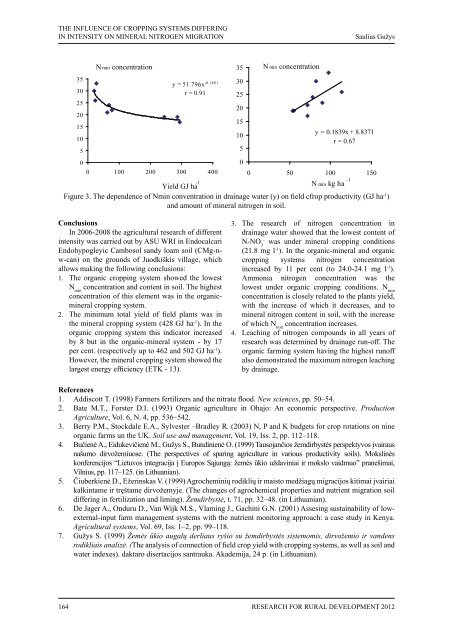RESEARCH FOR
RESEARCH FOR
RESEARCH FOR
You also want an ePaper? Increase the reach of your titles
YUMPU automatically turns print PDFs into web optimized ePapers that Google loves.
THE INFLUENCE OF CROPPING SYSTEMS DIFFERING<br />
IN INTENSITY ON MINERAL NITROGEN MIGRATION<br />
35<br />
30<br />
25<br />
20<br />
15<br />
10<br />
5<br />
N min concentration<br />
y = 51.796x -0.1881<br />
r = 0.91<br />
y = 0.1839x + 8.8371<br />
r = 0.67<br />
0<br />
0 100 200 300 400<br />
Yield GJ ha -1<br />
0<br />
0 50 100 150<br />
N min kg ha -1<br />
Figure 3. The dependence of Nmin conventration in drainage water (y) on field cfrop productivity (GJ ha-1 )<br />
and amount of mineral nitrogen in soil.<br />
conclusions<br />
In 2006-2008 the agricultural research of different<br />
intensity was carried out by ASU WRI in Endocalcari<br />
Endohypogleyic Cambosol sandy loam soil (CMg-nw-can)<br />
on the grounds of Juodkiškis village, which<br />
allows making the following conclusions:<br />
1. The organic cropping system showed the lowest<br />
N min concentration and content in soil. The highest<br />
concentration of this element was in the organicmineral<br />
cropping system.<br />
2. The minimum total yield of field plants was in<br />
the mineral cropping system (428 GJ ha -1 ). In the<br />
organic cropping system this indicator increased<br />
by 8 but in the organic-mineral system - by 17<br />
per cent. (respectively up to 462 and 502 GJ ha -1 ).<br />
However, the mineral cropping system showed the<br />
largest energy efficiency (ETK - 13).<br />
164 ReseaRch foR RuRal Development 2012<br />
35<br />
30<br />
25<br />
20<br />
15<br />
10<br />
5<br />
N min concentration<br />
Saulius Gužys<br />
3. The research of nitrogen concentration in<br />
drainage water showed that the lowest content of<br />
- N-NO was under mineral cropping conditions<br />
3<br />
(21.8 mg l-1 ). In the organic-mineral and organic<br />
cropping systems nitrogen concentration<br />
increased by 11 per cent (to 24.0-24.1 mg l-1 ).<br />
Ammonia nitrogen concentration was the<br />
lowest under organic cropping conditions. Nmin concentration is closely related to the plants yield,<br />
with the increase of which it decreases, and to<br />
mineral nitrogen content in soil, with the increase<br />
of which N concentration increases.<br />
min<br />
4. Leaching of nitrogen compounds in all years of<br />
research was determined by drainage run-off. The<br />
organic farming system having the highest runoff<br />
also demonstrated the maximum nitrogen leaching<br />
by drainage.<br />
references<br />
1. Addiscott T. (1998) Farmers fertilizers and the nitrate flood. New sciences, pp. 50–54.<br />
2. Bate M.T., Forster D.I. (1993) Organic agriculture in Ohajo: An economic perspective. Production<br />
Agriculture, Vol. 6, N. 4, pp. 536–542.<br />
3. Berry P.M., Stockdale E.A., Sylvester –Bradley R. (2003) N, P and K budgets for crop rotations on nine<br />
organic farms un the UK. Soil use and management, Vol. 19, Iss. 2, pp. 112–118.<br />
4. Bučienė A., Eidukevičienė M., Gužys S., Bundinienė O. (1999) Tausojančios žemdirbystės perspektyvos įvairaus<br />
našumo dirvožemiuose. (The perspectives of sparing agriculture in various productivity soils). Mokslinės<br />
konferencijos “Lietuvos integracija į Europos Sąjungą: žemės ūkio uždaviniai ir mokslo vaidmuo” pranešimai,<br />
Vilnius, pp. 117–125. (in Lithuanian).<br />
5. Čiuberkienė D., Ežerinskas V. (1999) Agrocheminių rodiklių ir maisto medžiagų migracijos kitimai įvairiai<br />
kalkintame ir tręštame dirvožemyje. (The changes of agrochemical properties and nutrient migration soil<br />
differing in fertilization and liming). Žemdirbystė, t. 71, pp. 32–48. (in Lithuanian).<br />
6. De Jager A., Onduru D., Van Wijk M.S., Vlaming J., Gachini G.N. (2001) Assesing sustainability of lowexternal-input<br />
farm management systems with the nutrient monitoring approach: a case study in Kenya.<br />
Agricultural systems, Vol. 69, Iss. 1–2, pp. 99–118.<br />
7. Gužys S. (1999) Žemės ūkio augalų derliaus ryšio su žemdirbystės sistemomis, dirvožemio ir vandens<br />
rodikliais analizė. (The analysis of connection of field crop yield with cropping systems, as well as soil and<br />
water indexes). daktaro disertacijos santrauka. Akademija, 24 p. (in Lithuanian).


